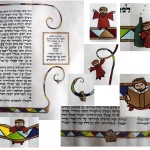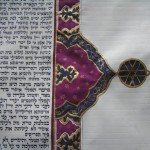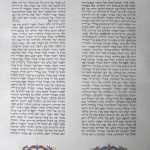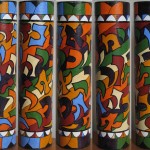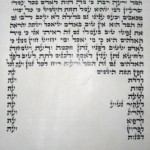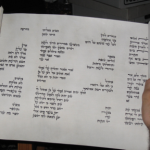Megillat Esther
The Scroll of Esther is read in the synagogue on Purim. While most people follow along in a printed text, the person reading out loud for everybody must read from a kosher scroll. Esther is written on parchment, with special kosher ink, and a quill, with the same script as in a sefer Torah. Esther scrolls may be illuminated with decorative borders or pictures around the text – a traditional decoration is a crown at the top of some or all columns.
Megillot come in various formats, from a tiny scroll 11 lines high, to a large scroll of 42 lines. I personally like to write Esther in a scroll about 12-15 inches high, with 21 or 28 lines to a column. In most layouts, almost every column starts with the word “Ha’melech” – the king. Another type of layout starts each column with a letter vav – a hook, hooking the words to heaven.
Esther may be illustrated. The illustration depends very much on the client’s taste.
Other Megillot
The other Megillot used in the liturgy (Eicha, Kohelet, Shir ha’Shirim, and Ruth) are usually read from printed books. The same is true of the Haftarot read on Shabbat and festivals. However, some communities give these readings extra honour by reading them from a scroll also.
Megillat ha’Shoah
 In 2003, the Conservative Movement introduced a new liturgical rite for Yom ha’Shoah, Holocaust Remembrance Day. As part of the service, Megillat ha’Shoah – the Holocaust Remembrance Scroll – is read. Megillat ha’Shoah was written by Avigdor Shinan, a professor of Hebrew literature at the Hebrew University in Jerusalem.
In 2003, the Conservative Movement introduced a new liturgical rite for Yom ha’Shoah, Holocaust Remembrance Day. As part of the service, Megillat ha’Shoah – the Holocaust Remembrance Scroll – is read. Megillat ha’Shoah was written by Avigdor Shinan, a professor of Hebrew literature at the Hebrew University in Jerusalem.
The scroll has a special and beautiful layout, designed by Mordechai Pinchas, a sofer working in the UK. The image shown is his work.

